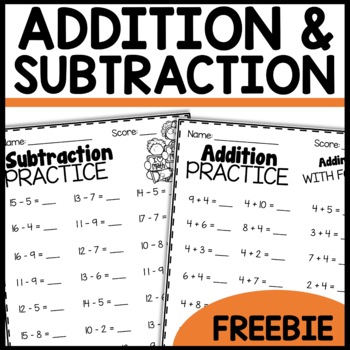Shanon Juneau We are Better Together
11.2k Followers
Grade Levels
1st
Subjects
Resource Type
Standards
CCSS1.OA.B.3
CCSS1.OA.B.4
CCSS1.OA.C.5
CCSS1.OA.C.6
Formats Included
- PDF
Pages
10 pages
Shanon Juneau We are Better Together
11.2k Followers
Also included in
- These mixed addition and subtraction math worksheets are the perfect "addition" to your math STASH! Just grab and go when your kiddos need a bit of practice or when you need something for a sub! BUNDLED FOR CONVENIENCEYOU WILL SAVE 20% IF YOU PURCHASE THE BUNDLE!♥HERE ARE SOME OTHER RESOURCES YOUPrice $14.00Original Price $18.25Save $4.25
Description
These mixed addition and subtraction within 20 worksheets FREEBIE is a great "addition" to your math STASH! Just grab and go when your kiddos need a bit of practice or when you need something for a sub!
BELOW ARE RELATED PRODUCTS:
WHO LIKES A DEAL?
- Follow me and be notified when new products are uploaded. New products are always 50% off for the first 24 hours they are posted (except for resources that are under $1.50). It pays to follow me!
QUESTIONS OR CONCERNS
- Email me at scjuneau@yahoo.com if you have any questions or concerns about this product.
Thank you for visiting my store! Please contact me if you have any questions!
I sure appreciate you!
Shanon Juneau ❤️
We Are Better Together
Total Pages
10 pages
Answer Key
N/A
Teaching Duration
Lifelong tool
Last updated Feb 14th, 2022
Report this resource to TPT
Reported resources will be reviewed by our team. Report this resource to let us know if this resource violates TPT’s content guidelines.
Standards
to see state-specific standards (only available in the US).
CCSS1.OA.B.3
Apply properties of operations as strategies to add and subtract. If 8 + 3 = 11 is known, then 3 + 8 = 11 is also known. (Commutative property of addition.) To add 2 + 6 + 4, the second two numbers can be added to make a ten, so 2 + 6 + 4 = 2 + 10 = 12. (Associative property of addition.)
CCSS1.OA.B.4
Understand subtraction as an unknown-addend problem. For example, subtract 10 – 8 by finding the number that makes 10 when added to 8.
CCSS1.OA.C.5
Relate counting to addition and subtraction (e.g., by counting on 2 to add 2).
CCSS1.OA.C.6
Add and subtract within 20, demonstrating fluency for addition and subtraction within 10. Use strategies such as counting on; making ten (e.g., 8 + 6 = 8 + 2 + 4 = 10 + 4 = 14); decomposing a number leading to a ten (e.g., 13 - 4 = 13 - 3 - 1 = 10 - 1 = 9); using the relationship between addition and subtraction (e.g., knowing that 8 + 4 = 12, one knows 12 - 8 = 4); and creating equivalent but easier or known sums (e.g., adding 6 + 7 by creating the known equivalent 6 + 6 + 1 = 12 + 1 = 13).






